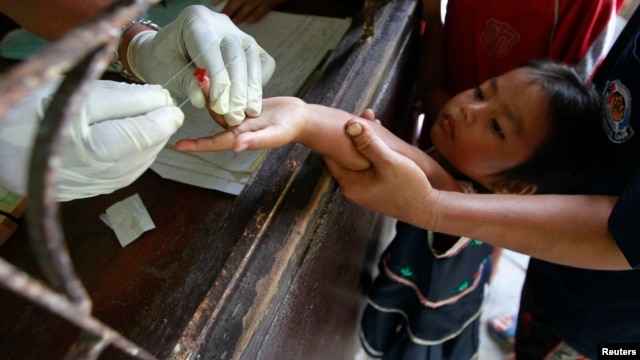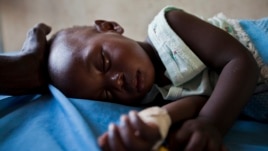Children living along the Thai-Burma border come to a malaria clinic in Sai Yoke district, Kanchanaburi Province, to get tested, October 26,2012.
LONDON — The poorest children in the world's most impoverished communities are twice as likely to contract malaria as the least poor, according to a new study published in the Lancet medical journal Wednesday.
Researchers say the study, led by Britain’s Durham University and the London School of Hygiene and Tropical Medicine, suggests that alleviating poverty could protect children from malaria.
Durham University Professor Steve Lindsay, who led the research, says the study highlights a possible new approach to tackling the often fatal mosquito-borne disease.
“What is novel about this is thinking about malaria not just through getting bed nets out or better medicines," Lindsay said. "But we can actually improve or reduce malaria by assisting development in these communities.”
The research published on Wednesday is based on an analysis of nearly 5,000 English-language studies published over the past three decades. Those studies were conducted in poor communities in Africa and Asia, focusing on children up to the age of 15.
The youngsters were ranked by several factors including family assets, such as whether they have access to a bicycle or radio, levels of education, and skill sets.
By linking levels of malaria to socio-economic status, the research finds that the poorest people are hit the hardest. As an example, Lindsay explains how inadequate housing impacts the spread of malaria.
“80 percent of malaria transmission occurs indoors at night," he said. "So if you have a nice house where it is not so leaky, you have got screening on the doors, and you may have a ceiling, then you will get fewer mosquitos coming indoors.”
Other development factors also play a role, like eating a nutritious diet or having an education, which helps people make informed decisions about malaria prevention, said Lindsay.
The study is an attempt to unite the scientific and development communities, so that the two can work together to tackle malaria.
“We are being a wee bit provocative here with our hypothesis," said Lindsay. "First of all, scientists need to look at what are the mechanisms for where development, in its broad sense, is protective. And then look at ways of intervening -- better housing, better education, helping to improve the general welfare of communities and how that might impact and reduce malaria.”
More than 2.5 billion people are at risk of malaria. The disease is endemic in more than 100 countries around the world.
Researchers say the study, led by Britain’s Durham University and the London School of Hygiene and Tropical Medicine, suggests that alleviating poverty could protect children from malaria.
Durham University Professor Steve Lindsay, who led the research, says the study highlights a possible new approach to tackling the often fatal mosquito-borne disease.
“What is novel about this is thinking about malaria not just through getting bed nets out or better medicines," Lindsay said. "But we can actually improve or reduce malaria by assisting development in these communities.”
The research published on Wednesday is based on an analysis of nearly 5,000 English-language studies published over the past three decades. Those studies were conducted in poor communities in Africa and Asia, focusing on children up to the age of 15.
The youngsters were ranked by several factors including family assets, such as whether they have access to a bicycle or radio, levels of education, and skill sets.
By linking levels of malaria to socio-economic status, the research finds that the poorest people are hit the hardest. As an example, Lindsay explains how inadequate housing impacts the spread of malaria.
“80 percent of malaria transmission occurs indoors at night," he said. "So if you have a nice house where it is not so leaky, you have got screening on the doors, and you may have a ceiling, then you will get fewer mosquitos coming indoors.”
Other development factors also play a role, like eating a nutritious diet or having an education, which helps people make informed decisions about malaria prevention, said Lindsay.
The study is an attempt to unite the scientific and development communities, so that the two can work together to tackle malaria.
“We are being a wee bit provocative here with our hypothesis," said Lindsay. "First of all, scientists need to look at what are the mechanisms for where development, in its broad sense, is protective. And then look at ways of intervening -- better housing, better education, helping to improve the general welfare of communities and how that might impact and reduce malaria.”
More than 2.5 billion people are at risk of malaria. The disease is endemic in more than 100 countries around the world.













No comments:
Post a Comment